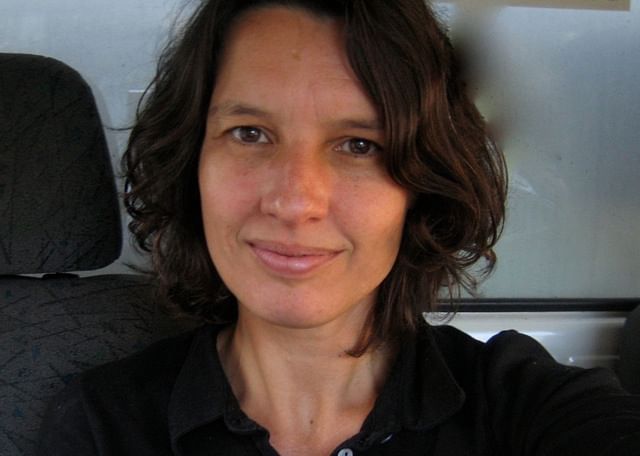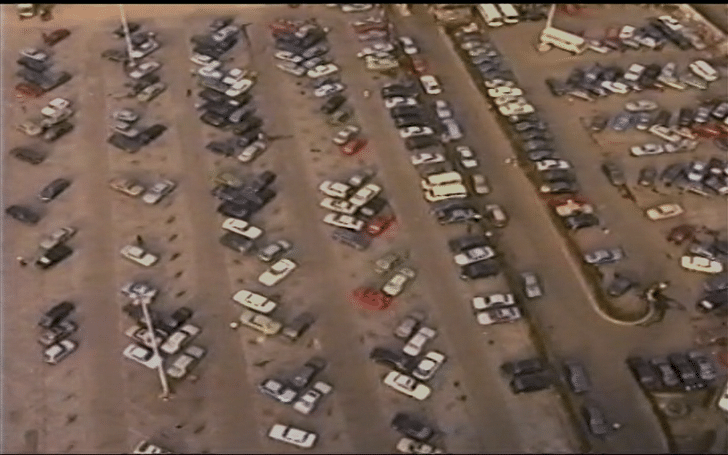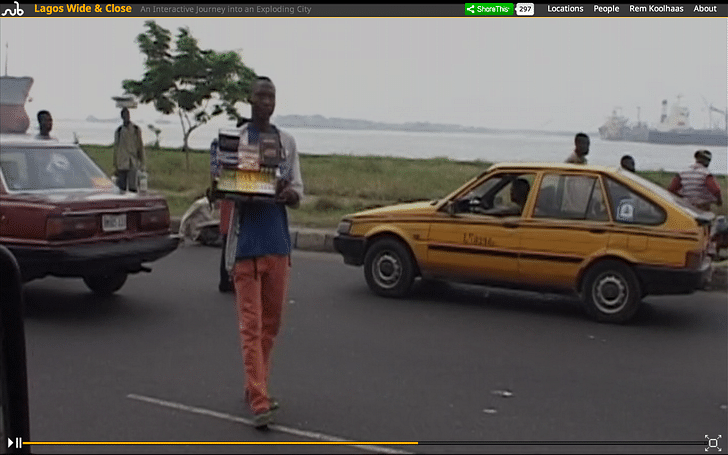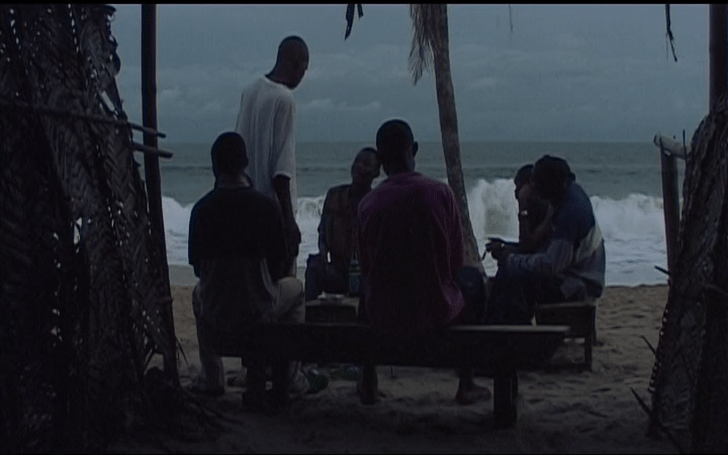

Several weeks ago, we featured Bregtje van der Haak's interactive documentary, Lagos Close and Wide: an Interactive Journey into an Exploding City, originally released as a DVD in 2004 and now available online. The project emerged from van der Haak's 2001 trip to Lagos, Nigeria with the architect Rem Koolhaas and their attempt to capture the city at a crucial moment in its emergence as the fastest growing city on the continent. ("Every hour, fifty new people start their lives in Lagos" states the film's description). The documentary utilizes a novel and innovative format in which the information is organized by distance – close-up, through the perspective of bus driver Olawole Busayo, and the more distant perspective typical of many urban studies. Users choose between these visual perspectives as well as various audio by Koolhaas and Lagosians. We recently touched base with van der Haak to better understand her motivations behind the project and experiences of making it.
Lagos Close and Wide is – at least for me – a new way of experiencing a documentary. How did you develop this presentation format?
First I made a linear documentary film with Rem Koolhaas in Lagos, called Lagos/Koolhaas (60 minutes, video, produced by Pieter van Huystee Film & Television). It premiered at IDFA in 2002.
However, I was not satisfied with what we could show about the immense complexity and dynamism of urban life in Lagos in this traditional format. Also, we had collected 50 hours of unique footage. Very little documentation of Lagos existed and I felt we should savor it and make it available somehow. Filming public space has long been prohibited by military leaders in Nigeria in the past. Few filmmakers and journalists had made the effort to document Lagos extensively. It is costly, time consuming and can be dangerous at times. Therefore, when presented, I accepted the opportunity to work with designer Silke Wawro in a media lab funded by the Dutch cultural media fund to develop a new film format, that would do more justice to the complexity of Lagos and also provide a more immersive (inter)active experience of Lagos to viewers. I wanted to convey the experience of “being there”. That’s why, after reviewing the fifty hours of footage, I decided to focus on the perspective of Olawole Busayo, bus driver. He’s immersed in the city every day. I separated the close shots from the wide shots in the fifty hours of unused video and started to organise both the wide and the close shots in two parallel films, running each on a one hour time line. Together, they chronicle a day in Olawole’s life.
Looking back on the 2003 DVD iteration of your research, do you perceive deficiencies that influenced or necessitated an alternative mode of exhibiting your research?
I felt the linear storytelling mode was very constraining and could not do justice to my experience of Lagos, viewing and exploring it with Rem Koolhaas. His perspective usually tended to a bird’s eye perspective, quite analytical and removed. I tended to get involved and entangled on the ground more. I wanted to bring these two perspectives together in one film, because I felt they could enrich each other. Combining them in one film would add to understanding Lagos life, I thought, and also get rid of the hubris of the idea that we would come and visit for a few weeks and then make some kind of final, definite statement about such a hugely complex city…
[Koolhaas'] perspective usually tended to a bird’s eye perspective, quite analytical and removed. I tended to get involved and entangled on the ground more. I wanted to bring these two perspectives together in one film, because I felt they could enrich each other.
How do you perceive Lagos has changed since the beginning your work there?
I went back in the fall of 2012 twice, for two weeks, to film a new documentary about the Redeemed Christian Church of God, a pentecostal mega-church outside of Lagos. One of our main characters was living in Lagos and commuted regularly from Lagos to the RCCG Redemption Camp (north of Lagos, along the Ibadan Expressway), which was my main location for shooting that time. With her, I passed by many of the locations that are part of Lagos Wide & Close. As far as I could see in passing, some had stayed unchanged (eg. Makoko Sawmill) and others had changed dramatically (eg. the recycling plant area had completely disappeared and replaced by a green lawn)

You have expressed the difficulty of conveying the experience of being in Lagos on film. What is un-representable in the city?
The fact that everyone in Lagos is prepared to live with risk, improvisation and perpetual insecurity and change. Every time we had made a plan for filming based on our research, we had to adapt the plan, because the situation had changed by the time we started filming. This lead me to believe that it would be senseless and pointless to present one closed and finite visual statement about this city.
Every time we had made a plan for filming based on our research, we had to adapt the plan, because the situation had changed by the time we started filming.
How did the specificities of the mediums used inform the work?
The DVD Lagos Wide & Close (and the online adaptation of this interactive film) provide several options for viewers to explore Lagos and to be immersed in it. Two video channels and three audio channels provide six different perspectives on Lagos. Combining image and sound in 2 x 3 ways opens up the medium of film for a layered experience rather than a linear storyline. I like the fact that you can only see one video channel at a time. When you’re watching Olawole Busayo’s itinerary from a close perspective, you miss the wide shots and aerial shots of that part of his bus route. When you switch to the aerial views, you don’t see the bus and Olawole up close anymore. This structure of the interactive film reminds me of spatial perspectives in architecture (the city looks different from the ground floor than from the 30th floor of a building). This format also brings me closer to my own experience of Lagos as a filmmaker, where I never felt I got ’the whole picture’, only fragments, bits and pieces, temporary snapshots of a city that is constantly changing.
The '2 video x 3 audio' format (online and on the DVD) also provide a chance for viewers to engage more actively with the city and to explore it by combining different perspectives. Through rethinking our representation of Lagos, I think we discovered a very interesting format for documentary storytelling in general. When you change the audio you will see the same images in a different way (and what you see influences your perception of spoken text as well). It is not only much richer in providing multiple perspectives on the same subject, it also shows that the same image takes on a different meaning when the audio is changed.

I also am curious about the receptability of Lagos Close and Wide in Lagos. Can Nigerians experience this research? How prevalent is internet access in Lagos today?
Lagos is totally connected and the Internet is it is very prevalent in Lagos, although not always stable. I would like to test the online version in a few locations in Lagos, but I have not yet had an opportunity to do so. Buffering of the images may take longer in some places (not just in Lagos by the way).
I tend to regard film editing as a kind of building/architecture.
How has Lagos influenced your own work as film-maker? Has the city influenced the structure of your research or its presentation?
Yes, the project has definitely influenced me as a filmmaker. Since then, I continue to develop interactive films and transmedia projects in addition to linear documentaries. Whenever I feel constrained, I leap out into new forms.
Most recently the dynamic book and website, Atlas of Pentecostalism
http://www.atlasofpentecostalism.net/index.php, in parallel with the linear documentary The Prosperity Gospel: https://vimeo.com/64963336
In addition, I think it has heightened my consciousness of space. I have a strong spatial interest in my films, and I tend to regard film editing as a kind of building/architecture.

Writer and fake architect, among other feints. Principal at Adjustments Agency. Co-founder of Encyclopedia Inc. Get in touch: nicholas@archinect.com
No Comments
Block this user
Are you sure you want to block this user and hide all related comments throughout the site?
Archinect
This is your first comment on Archinect. Your comment will be visible once approved.